
The Cheirogaleidae are the family of strepsirrhine primates containing the various dwarf and mouse lemurs. Like all other lemurs, cheirogaleids live exclusively on the island of Madagascar.

The Indriidae are a family of strepsirrhine primates. They are medium- to large-sized lemurs, with only four teeth in the toothcomb instead of the usual six. Indriids, like all lemurs, live exclusively on the island of Madagascar.

Lemuridae is a family of strepsirrhine primates native to Madagascar and the Comoros. They are represented by the Lemuriformes in Madagascar with one of the highest concentration of the lemurs. One of five families commonly known as lemurs. These animals were once thought to be the evolutionary predecessors of monkeys and apes, but this is no longer considered correct. They are formally referred to as lemurids.

A sifaka is a lemur of the genus Propithecus from the family Indriidae within the order Primates. The name of their family is an onomatopoeia of their characteristic "shi-fak" alarm call. Like all lemurs, they are found only on the island of Madagascar. All species of sifakas are threatened, ranging from endangered to critically endangered.

The indri, also called the babakoto, is one of the largest living lemurs, with a head-body length of about 64–72 cm and a weight of between 6 and 9.5 kg. It has a black and white coat and maintains an upright posture when climbing or clinging. It is monogamous and lives in small family groups, moving through the canopy, and is herbivorous, feeding mainly on leaves but also seeds, fruits, and flowers. The groups are quite vocal, communicating with other groups by singing, roaring and other vocalisations. Besides humans, it is the only mammal found that can use rhythm.
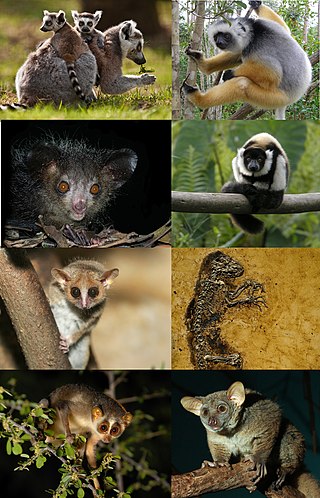
Strepsirrhini or Strepsirhini is a suborder of primates that includes the lemuriform primates, which consist of the lemurs of Madagascar, galagos ("bushbabies") and pottos from Africa, and the lorises from India and southeast Asia. Collectively they are referred to as strepsirrhines. Also belonging to the suborder are the extinct adapiform primates which thrived during the Eocene in Europe, North America, and Asia, but disappeared from most of the Northern Hemisphere as the climate cooled. Adapiforms are sometimes referred to as being "lemur-like", although the diversity of both lemurs and adapiforms does not support this comparison.

Lemurs are wet-nosed primates of the superfamily Lemuroidea, divided into 8 families and consisting of 15 genera and around 100 existing species. They are endemic to the island of Madagascar. Most existing lemurs are small, have a pointed snout, large eyes, and a long tail. They chiefly live in trees and are active at night.

The ring-tailed lemur is a medium- to larger-sized strepsirrhine (wet-nosed) primate and the most internationally recognized lemur species, owing to its long, black-and-white, ringed tail. It belongs to Lemuridae, one of five lemur families, and is the only member of the Lemur genus. Like all lemurs, it is endemic to the island of Madagascar, where it is endangered. Known locally in Malagasy as maky or hira, it ranges from gallery forests to spiny scrub in the southern regions of the island. It is omnivorous, as well as the most adapted to living terrestrially of the extant lemurs.
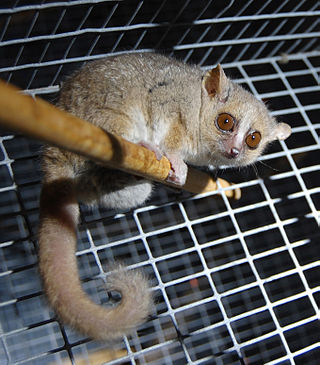
The gray mouse lemur, grey mouse lemur or lesser mouse lemur is a small lemur, a type of strepsirrhine primate, found only on the island of Madagascar. Weighing 58 to 67 grams, it is the largest of the mouse lemurs, a group that includes the smallest primates in the world. The species is named for its mouse-like size and coloration and is known locally as tsidy, koitsiky, titilivaha, pondiky, and vakiandry. The gray mouse lemur and all other mouse lemurs are considered cryptic species, as they are nearly indistinguishable from each other by appearance. For this reason, the gray mouse lemur was considered the only mouse lemur species for decades until more recent studies began to distinguish between the species.
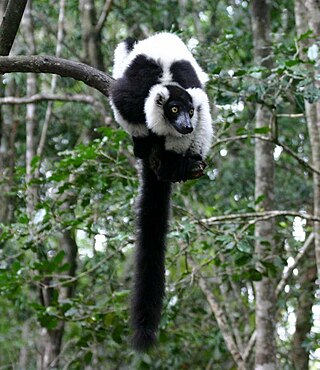
The ruffed lemurs of the genus Varecia are strepsirrhine primates and are the largest extant lemurs within the family Lemuridae. Like all living lemurs, they are found only on the island of Madagascar. Formerly considered to be a monotypic genus, two species are now recognized: the black-and-white ruffed lemur, with its three subspecies, and the red ruffed lemur.
OBJ is a geometry definition file format first developed by Wavefront Technologies for its Advanced Visualizer animation package. The file format is open and has been adopted by other 3D graphics application vendors.
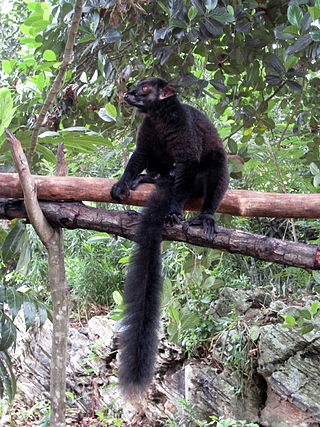
The black lemur is a species of lemur from the family Lemuridae. Like all lemurs, it is endemic to Madagascar. Originally, the species was thought to have two subspecies, Eulemur macaco macaco and Eulemur macaco flavifrons, both of which were elevated to species status by Mittermeier et al. in 2008 to Eulemur macaco and Eulemur flavifrons respectively. The most startling difference between the two species is the eye colour; Eulemur flavifrons, the blue-eyed black lemur, has blue eyes, while Eulemur macaco, the black lemur, has brown or orange eyes, and also has ear tufts.

The red ruffed lemur is one of two species in the genus Varecia, the ruffed lemurs; the other is the black-and-white ruffed lemur. Like all lemurs, it is native to Madagascar. It occurs only in the rainforests of Masoala, in the northeast of the island. It is one of the largest primates of Madagascar with a body length of 53 cm, a tail length of 60 cm and a weight of 3.3–3.6 kg. Its soft, thick fur is red and black in color and sports a buff or cream colored spot at the nape, but a few are known to have a white or pink patch on the back of the limbs or digits and a ring on the base of the tail in a similar color.
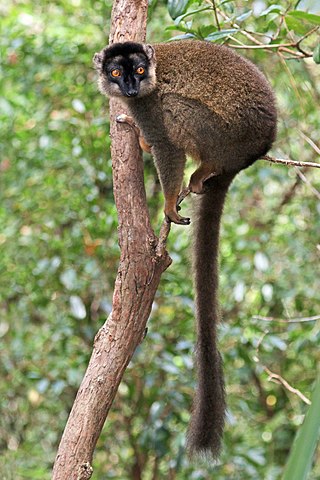
The common brown lemur is a species of lemur in the family Lemuridae. It is found in Madagascar and has been introduced to Mayotte.

The collared brown lemur, also known as the red-collared brown lemur or red-collared lemur, is a medium-sized strepsirrhine primate and one of twelve species of brown lemur in the family Lemuridae. It is only found in south-eastern Madagascar. Like most species of lemur, it is arboreal, moving quadrupedally and occasionally leaping from tree to tree. Like other brown lemurs, this species is cathemeral, lives in social groups, primarily eats fruit, exhibits sexual dichromatism, and does not demonstrate female dominance. The species is listed as Endangered by the International Union for Conservation of Nature (IUCN) and is threatened primarily by habitat loss.

Pachylemur is an extinct, giant lemur most closely related to the ruffed lemurs of genus Varecia. Two species are known, Pachylemur insignis and Pachylemur jullyi, although there is some doubt as to whether or not they may actually be the same species. Pachylemur is sometimes referred to as the giant ruffed lemur, because although it and the living ruffed lemurs had similar teeth and skeletons, Pachylemur was more robust and as much as three to four times larger. DNA studies have confirmed a sister group relationship between these two types of lemur. Like living ruffed lemurs, Pachylemur specialized in eating fruit, and was therefore an important seed disperser, possibly for tree species with seeds too large for even ruffed lemurs to swallow. In the spiny thickets of southwestern Madagascar, they were also likely to have dispersed seeds evolved to attach to fur and be carried away. Unlike ruffed lemurs, the fore- and hindlimbs of Pachylemur were nearly the same length, and therefore it was likely to be a slow, deliberate climber. However, both used hindlimb suspension to reach fruit on small branches below them.

Lemurs, primates belonging to the suborder Strepsirrhini which branched off from other primates less than 63 million years ago, evolved on the island of Madagascar, for at least 40 million years. They share some traits with the most basal primates, and thus are often confused as being ancestral to modern monkeys, apes, and humans. Instead, they merely resemble ancestral primates.
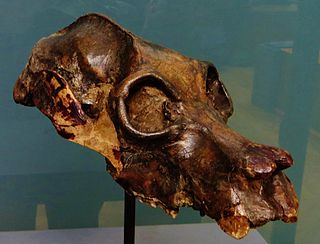
Subfossil lemurs are lemurs from Madagascar that are represented by recent (subfossil) remains dating from nearly 26,000 years ago to approximately 560 years ago. They include both extant and extinct species, although the term more frequently refers to the extinct giant lemurs. The diversity of subfossil lemur communities was greater than that of present-day lemur communities, ranging to as high as 20 or more species per location, compared with 10 to 12 species today. Extinct species are estimated to have ranged in size from slightly over 10 kg (22 lb) to roughly 160 kg (350 lb). Even the subfossil remains of living species are larger and more robust than the skeletal remains of modern specimens. The subfossil sites found around most of the island demonstrate that most giant lemurs had wide distributions and that ranges of living species have contracted significantly since the arrival of humans.

The black-and-white ruffed lemur is an endangered species of ruffed lemur, one of two which are endemic to the island of Madagascar. Despite having a larger range than the red ruffed lemur, it has a much smaller population that is spread out, living in lower population densities and reproductively isolated. It also has less coverage and protection in large national parks than the red ruffed lemur. Three subspecies of black-and-white ruffed lemur have been recognized since the red ruffed lemur was elevated to species status in 2001.

Lemurs were first classified in 1758 by Carl Linnaeus, and the taxonomy remains controversial today, with approximately 70 to 100 species and subspecies recognized, depending on how the term "species" is defined. Having undergone their own independent evolution on Madagascar, lemurs have diversified to fill many ecological niches normally filled by other types of mammals. They include the smallest primates in the world, and once included some of the largest. Since the arrival of humans approximately 2,000 years ago, lemurs have become restricted to 10% of the island, or approximately 60,000 square kilometers (23,000 sq mi), and many face extinction. Concerns over lemur conservation have affected lemur taxonomy, since distinct species receive increased conservation attention compared to subspecies.



















